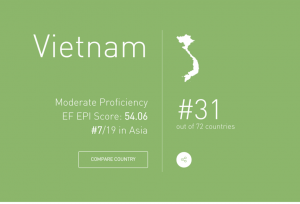Sound Conversations: Oral Language Solutions for Vietnamese Language Learners




“I am tomorrow, or some future day, what I establish today. I am today what I established yesterday or some previous day.”
– James Joyce (1882-1941), Irish novelist
How many Vietnamese English language learners (ELLs) are in the United States? What are the specific challenges many Vietnamese learners of English face? What ESL classroom techniques and personal edtech tools can help improve both clarity and fluency in speaking English?
Teresa Nguyen and I addressed these questions in a 2016 State CATESOL conference presentation, titled “Sound Conversations: Oral Language Solutions for Vietnamese English Language Learners.” By sharing our own teaching experiences with students both in Vietnam and stateside, we examined the unique verbal challenges faced by Vietnamese ELLs while providing additional classroom-tested exercises to help these students develop their pronunciation and conversation skills.
Who are the Vietnamese English Language Learners in the U.S.?
The United States currently hosts 1.2 million international students. Within that group, Vietnamese students are the 6th largest faction. These students – largely studying at the college/university level– are spread out over all 50 states, with a majority (54.7%) being female (source). There are also an estimated 847,000 Vietnamese Americans which the government classifies as having “limited English proficiency.” The 2016 Pulitzer Prize author Viet Thanh Nguyen brought more attention to this American refugee community in his bestseller “The Sympathizer” (click here for the New York Times’ review).
Zooming out a bit beyond the United States, let’s look at English proficiency among Vietnamese English language learners inside Vietnam. EF’s English Proficiency Index, typically analyzing data from the 18-30 demographic, provides “a standardized measurement of adult English language performance comparable between countries,” excluding speaking skills. Each country, once assessed, is then ranked from Very High to Very Low. For instance, Vietnam placed 7th in the nineteen Asian countries ranked, and 31st, or “Moderate,” on the global proficiency scale.

Vietnam Ranks Higher Than Expected in EF English Proficiency Index
This ranking might be higher than expected, especially given the position of Japan – a much wealthier nation – at #35. The score might also reflect the strength of the relatively few schools selected rather than an accurate snapshot of all Vietnamese language learners.
Yet setting aside the question of sample bias, there are several inherent challenges when transitioning from Vietnamese to English. For starters, Vietnamese is a monosyllabic language, meaning there is only one syllable per word. English words, on the other hand, vary in their syllable count. The Vietnamese language also often omits final consonants and possesses no short vowels – the opposite of English oral mechanics.
EdTech Can Help!
So the question remains, how do we target these language-specific obstacles in the classroom? What tools and exercises are available? What communicative activities work with Vietnamese English language learners?
We’ve found apps like Elsa Speak and duoLingo incredibly helpful both in and outside of class. Pronunciation videos from YouTube channels like Accurate English and ESL Garage are likewise valuable, particularly for independent study. Introducing students to these resources allows them to study English outside of the limited ESL classroom hours and encourages adult learners to become more autotelic.
However, our personal teaching philosophy has always been that English proficiency goes beyond an understanding of grammar mechanics. We believe balancing these studies with communicative, fluency-focused activities leads to sound conversations and more confident English speakers.
Recommended Classroom Activities
Students want to hold conversations that go beyond mere transactional English. Therefore, strong conversation skills receive considerable attention. We recommend providing classroom time for a variety of simple, closed questions to more complicated open questions.
Many exercises in our ESL textbook Compelling Conversations Vietnam: Speaking Exercises for Vietnamese Learners of English have been specifically designed to increase fluency, share information, and encourage reflection.
Search and Share
This internet, research-based activity asks students to search for information, summarize it, and share the information in small groups. Search and Shares work best as flexible homework assignments, and help ESL teachers flip the classroom while building independent study skills. The following list is but a sampling of the topics we explored with these exercises:
- Reviewing pronunciation tips
- Choosing a local restaurant
- Giving a product review
- Reducing stress and increasing happiness
- Becoming a movie critic
- Exploring a new city
Yet this flexible technique – also referred to as a ‘webquest’ –can be adapted to almost any subject.
Discussing Quotations and Paraphrasing Proverbs
Quotations and proverbs provide both authentic insights on both language and culture. We like asking students in small groups to read and evaluate famous quotations by important cultural figures. Then students say whether they agree or disagree, explain their opinions, and choose a favorite quote. For more advanced students, paraphrasing proverbs from Vietnam, the United States, and other countries can also re-enforce a vital communication skill.
Expanding A Working Vocabulary
For strengthening and expanding the working vocabulary of Vietnamese ELLs (English language learners), we recommend the study of prefixes and suffixes. Students can create their own lists or fill in complete charts to practice identifying the meanings of other words. Students often find systematically studying English words a satisfying way to expand their academic vocabulary. For this reason, we created Quizlet and Kahoot! worksheets for all the vocabulary in our latest book.
Compelling Conversations – Vietnam
In our book, Compelling Conversations – Vietnam: Speaking Exercises for Vietnamese Learners of English, we combined these techniques. You can download a sample chapter, Delicious Choices, here. The book reflects our personal experiences and suggestions for helping English learners become more confident, competent, and fluent speakers in English.
Do you have Vietnamese English language learners in your classroom? Which communicative exercises and techniques have your Vietnamese students found helpful? What apps do you recommend for pronunciation aids?
Ask more. Know more. Share more.
Create Compelling Conversations.
Visit www.CompellingConversations.com


